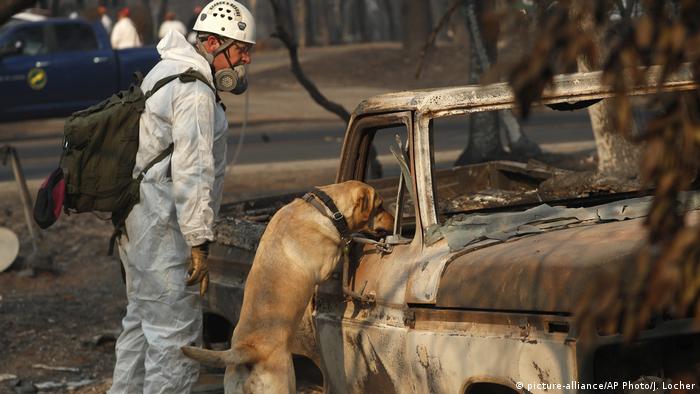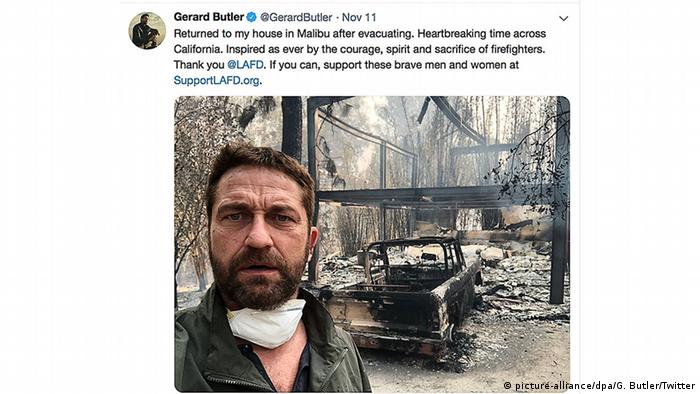仍有千人失踪美國森林大火損失超乎想像
加州北部的森林大火迄今至少造成71人死亡,另有上千人失踪。此次森林大火造成的損失之嚴重可能超過之前的估計。
(德國之聲中文網)在美國加州發生森林火災地區的臨時避難所,很多人拿著失踪親人的照片打聽他們的下落。該州巴特縣的警長霍內阿(Kory Honea)週五晚上列出了一份所有失踪居民的名單。他表示:"這是一份令人感到震撼的名單。"總共有1011人被列入名單,比前一天多400多人。
霍內阿說,這只是一份初步登記的名單,或許因打字錯誤或者因同一個人在多個地方同時被報失踪,從而有失踪人員被重複登記的可能性。但是從另一方面來看,當地還有許多居民根本就沒有申報失踪者的機會。
遇難者人數繼續增加
救援隊攜帶訓練有素的搜尋犬前往被大火燒毀的地區開展營救工作。消防人員已經成功地將火勢控制了一半。此次大火已經燒毀1200多棟房屋和其它建築。
週五, 此次加州北部森林大火造成的死亡人數又增加了8人。遇難者屍體在燒毀的房屋廢墟中被發現。當局表示,遇難者總數因此增加到71人。這是美國一百多年來導致死亡人數最多的森林火災。
特朗普視察災區
此外,此次大火蔓延速度太快是導致眾多人遇難的原因。在強風的作用下,火焰點燃乾燥的灌木和枯萎的樹木,導致火勢一次次迅猛擴大。
在毀滅性森林大火爆發一周後,美國總統特朗普宣布,他將於週六前往位於西海岸的加州。據白宮公佈的消息說,特朗普計劃看望受災群眾。
在毀滅性森林大火爆發一周後,美國總統特朗普宣布,他將於週六前往位於西海岸的加州。據白宮公佈的消息說,特朗普計劃看望受災群眾。
李京慧/雨涵(路透社、德新社、法新社)
DW.COM
Air Quality in California: Devastating Fire Leads to a New Danger
By Julie Turkewitz and Matt Richtel
PARADISE, Calif. — The wildfires that have laid waste to vast parts of California are presenting residents with a new danger: air so thick with smoke it ranks among the dirtiest in the world.
On Friday, residents of smog-choked Northern California woke to learn that their pollution levels now exceed those in cities in China and India that regularly rank among the worst.
In the communities closest to the Paradise fire, an apocalyptic fog cloaked the roads, evacuees wandered in white masks and officials said respiratory hospitalizations had surged. Nearly 200 miles to the south, in San Francisco, the smoke was so thick that health warnings prompted widespread school closings. Even the city’s cable cars were yanked from the streets.
And researchers warned that as large wildfires become more common — spurred by dryness linked to climate change — health risks will almost surely rise. “If this kind of air quality from wildfires doesn’t get people concerned,” said Dr. John Balmes, a pulmonologist at the University of California at San Francisco, “I don’t know what will.”
At fault, researchers say, is a confluence of two modern events: More people are moving to communities in and around wooded enclaves, pushed out by factors like the rising costs of housing and the desire to be closer to nature — just as warming temperatures are contributing to longer and more destructive wildfires.
Wood smoke contains some of the same toxic chemicals that city pollution does. While humans have long been around fire, they generally inhale it in small doses over cooking or heat fires. Humans have not, however, evolved to handle prolonged inhalation of caustic air from something like the Paradise blaze, Dr. Balmes said.
Research into the long-term health effects of large wildfires is still new. But a growing body of science shows how inhalation of minuscule particles from wood fires can nestle in the folds of lung tissue and do harm to the human immune system.
The body creates zealous responses to what it sees as an alien presence, and those effects can last for years by priming the body to overreact when it encounters subsequent lung irritation, said Dr. Kari Nadeau, a pediatric allergy and asthma specialist at Stanford.
From left, Parker Bush, Paige Bush, Fiona Nielsen, Erin Nielsen and Aiden Nielsen brought supplies for evacuees in Chico, Calif.Jenna Schoenefeld for The New York Times

In short, researchers like Dr. Nadeau believe that a person’s short-term exposure to wildfire can spur a lifetime of asthma, allergy and constricted breathing.
Officials statewide don’t have a grasp yet of how damaging and widespread the health effects of the smoke might be. Attention on Friday was focused on the death toll from the Paradise fire, north of Sacramento, which had reached 71 people. More than 1,000 people are still missing, according to Sheriff Kory Honea of Butte County.
The 142,000-acre fire was 45 percent contained, and officials said they expected to reach 100 percent by Nov. 30. Full containment does not mean that the fire is extinguished, only that firefighters were able to complete a perimeter around the flames and stop them from spreading.
That means that the health danger won’t disappear even as the firefighters make progress. Research already shows how that smoke directly affect lungs.
An extensive study of the 2015 wildfire season in Northern California found that smoke exposure led to increased emergency room visits for adults of all ages, but particularly those over 65 years old. One of the biggest research projects on the subject, the study looked at nearly 1.2 million emergency room visits during the summer of 2015, and found that during smoke-dense periods, there was a statistically significant increase in emergency room visits for heart attack, stroke and respiratory infection.
In recent days, as California’s air pollution map shifted from healthier green and yellow to red and purple — and then dark purple — officials from Los Angeles to North California urged residents to stay indoors and wear white N95 masks when they could not avoid leaving their homes. Even in Los Angeles, where smoke from the Woolsey fire had subsided by late Thursday, the air was still hazy and many schools required children to take recess inside.
For anyone who must go outside, the state public health department recommends P100 masks and N95 respirators, both of which are approved by the National Institute for Occupational Safety and Health for use by firefighters.
But Sacramento will no longer distribute N95 masks, warning that for those not living next to the fire, their risks outweigh their benefits. Risks include increased heart rate.
In the Bay Area, the National Weather Service said smoke would linger in the region into the coming week. The unhealthy air in Berkeley forced the California and Stanford football showdown to be pushed back until Dec. 1, the first postponement of the Big Game since the rivals’ 1963 match was delayed after the assassination of President John F. Kennedy.
In the communities around Paradise, air quality is considered hazardous for everyone, and the county health department is urging people to remain inside. But this has been difficult for evacuees. More than 81,000 people have been forced from their homes and many are sleeping outside in tents, unable to find other shelter.
Smoke from the Camp Fire lingered in Oakland, Calif.Jim Wilson/The New York Times

“I’ve got 18 grandkids here,” said Jewel Taylor, 50, an evacuee from nearby Magalia, standing in a hotel lobby where she had managed to find a room for the previous night. Next to her, Eli, 7, could not stop coughing.
Ms. Taylor said that she was most worried about her infant grandson, a 1-month-old named Evan who had developed a cough and goopy eyes. “What do you do when you see your kids like this?” she said, her voice catching. She said she had lived through other fires in the region, she added. “This is the worst. Ever.”
This week, some around Paradise said that when they inhaled, they could feel the particles cutting their throats. Others likened breathing to a persistent low-level anxiety attack.
“Let me put it this way,” said Becky Dearing, 66, who already has chronic obstructive pulmonary disease, “you almost feel like you’re choking.”
“We’re like zombies,” she went on, “walking around, all the unknowns.”
The precise biological mechanics of how people develop chronic lung problems, while not fully flushed out, lie at the intersection of two seemingly disparate scientific areas, immunology and environmental study.
Immune cells that respond to foreign particles douse the particles with toxins, among other tactics, to destroy them. But an intense event like extremely poor air quality can prompt such a strong immune response that it can throw the body’s delicate network out of balance, particularly in people predisposed to asthma or allergy.
A vicious cycle can begin where each time a person experiences even small, related stress — like smoke — the body overreacts, leading to constricted air flow and intensifying the risk of heart attack and stroke for some people.
Researchers say that climate change leads to this kind of ill health through wildfire, but also through prolonged pollen seasons, dust storms and other events that affect air quality.
“We’re setting up a tipping point in the immune system that leads to more inflammation and disease,” said Dr. Sharon Chinthrajah, a pulmonologist and allergist at Stanford, speaking of the way climate change has put increased pressure on human defenses.
“California,” she added, “is being reset to a new reality.”
Jennifer Medina contributed reporting from Los Angeles.
Follow Julie Turkewitz and Matt Richtel on Twitter: @julieturkewitz and @mrrichtel.
A version of this article appears in print on , on Page A1 of the New York edition with the headline: New Casualty As Fires Rage: California’s Air. Order Reprints | Today’s Paper | Subscribe



沒有留言:
張貼留言